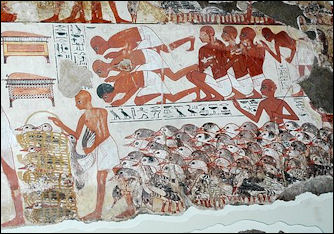LIVESTOCK AND DOMESTICATED ANIMALS IN ANCIENT EGYPT
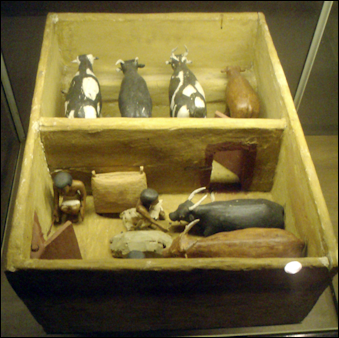
Cattle stable Robert Partridge of the BBC wrote: “Sheep were kept for their meat, milk, skins and wool, and flocks of sheep were used to trample newly sown seed into the ground. Rams, seen as a symbol of fertility, were identified with various gods, notably Khnum, a creator god, and Amun, the great god of the city of Thebes. Ram-headed sphinxes flank the entrance to the temple of Amun at Thebes. The bodies of some rams were mummified and equipped with gilded masks and even jewellery. [Source: Robert Partridge, BBC, February 17, 2011]
“The horse, along with the chariot, was introduced into Egypt relatively late in its history, around 1500 B.C. Chariots were pulled by two horses, and were used not only in battle, but also for ceremonial occasions and for hunting. Horses were bred in Egypt, and initially their rarity and novelty meant that they were a status symbol, owned only by wealthy and influential people. They were well looked after, and were given individual names, splendid stables and the best fodder. |::|
“Cattle were reared in great numbers in Egypt, and they were also imported, often as spoils of war. They were a prized possession, providing meat, milk, leather and horn. Their dung was burnt as fuel. Their leather was used to make thongs, sandals, chair seats and shields. Tomb scenes and tomb models often show the tomb owners inspecting their herds of cattle, and individual beasts were sometimes given pet names.” |::|
Websites on Ancient Egypt: UCLA Encyclopedia of Egyptology, escholarship.org ; Internet Ancient History Sourcebook: Egypt sourcebooks.fordham.edu ; Discovering Egypt discoveringegypt.com; BBC History: Egyptians bbc.co.uk/history/ancient/egyptians ; Ancient History Encyclopedia on Egypt ancient.eu/egypt; Digital Egypt for Universities. Scholarly treatment with broad coverage and cross references (internal and external). Artifacts used extensively to illustrate topics. ucl.ac.uk/museums-static/digitalegypt ; British Museum: Ancient Egypt ancientegypt.co.uk; Egypt’s Golden Empire pbs.org/empires/egypt; Metropolitan Museum of Art www.metmuseum.org ; Oriental Institute Ancient Egypt (Egypt and Sudan) Projects ; Egyptian Antiquities at the Louvre in Paris louvre.fr/en/departments/egyptian-antiquities; KMT: A Modern Journal of Ancient Egypt kmtjournal.com; Egypt Exploration Society ees.ac.uk ; Amarna Project amarnaproject.com; Abzu: Guide to Resources for the Study of the Ancient Near East etana.org; Egyptology Resources fitzmuseum.cam.ac.uk
Use and Treatment of Domesticated Animals in Ancient Egypt
Egyptians used animals, particularly sheep, for money. Gold pieces have been that are shaped like sheep. These are believed to have been early money. Cattle was raised on estates, primarily in the delta, to supply royalty with meat. Reliefs show men milking cows and slaughtering cattle on a large scale at a royal processing center.

cow calving
Chickens were raised in Egypt by 1400 B.C. The Egyptians hatched eggs by placing them in ovens. Pigeons were domesticated by the Egyptians and Romans, many were kept as sources source of meat that were available throughout the year. Their ancestors, rock pigeon, lived on cliffs and in caves on the coast. Domesticated pigeons were provided with tall towers with ledges for them to roost that simulated their coastal homes.
The Egyptians kept pigs but not for food. They were used as scavengers and to root through soil to prepare it for planting. Swineherds were a distinct class. According to Herodotus they were the most reviled class in Egypt. They were forbidden from entering temples.
Bulls were treated with reverence by Egyptians (black bulls in particular were given harems and palaces because they were believed to be related to the bull-god Apis).
According to Minnesota State University, Mankato: “Agricultural crops were not the mainstay of the ancient Egyptian diet. Rather, the Nile supplied a constant influx of fish which were cultivated year around. In addition to fish, water fowl and cattle were also kept by the Egyptians. Flocks of geese were raised from the earliest times and supplied eggs, meat and fat. However, the domestic fowl didn't make its appearance until Ramesside times, and then in only very isolated places. The Egyptian farmers, in their early experimental phase, also tried to domesticate other animals such as hyenas, gazelles and cranes but gave up after the Old Kingdom. Cattle were also part of the staple diet of the Egyptians, suggesting that grazing land was available for the Egyptians during the times when the Nile receded. However, during the inundation, cattle were brought to the higher levels of the flood plain area and were often fed the grains harvested from the previous year.” [Source: Minnesota State University, Mankato, ethanholman.com]
Wild Animals as Pets and Livestock in Ancient Egypt

pet cheetah
The Egyptian may have succeeded in domesticating cranes, ibex, gazelles, oryx and baboons. Bas reliefs show men trying to tame hyenas by tying them up and force feeding them meat.
The Egyptians were fond of cheetahs and kept herds of gazelles and antelopes. Oryxes and other kinds of antelope were kept as household pets. Even though the Egyptians may have tamed elephants there is no evidence they were domesticated like elephants in ancient Carthage.
Elephants in elaborate tombs were found in cemetery in Hierakonpolis, dated to 3500 B.C. One of the elephants was ten to eleven years old. That is the age when young males are expelled from the herd. Modern animals trainers say elephants at that age are young and inexperienced and can be captured and trained.
Early Domesticated Animals
The domestication of plants and animals took place around the same time. Hunter-gatherers and village horticulturists kept pets so they knew how to take care of animals. The domestication of animals took place when animals were raised as a source of food and labor. Grains were raised with the intent of feeding people and animals.
Some animals were domesticated so long ago that they have evolved as separate species. The process, some theorize, was as much accidental as intentional. With cats, for example, the anthropologist Richard Bullet suggests, the ancestors of cats were attracted to human settlements because they kept stores of grain that attracted mice they could fed on. Humans in turn tolerated the cats because they ate mice that fed on their grain and otherwise were not threatening.
Bullet as also theorized that horses, cattle and sheep were initially not domesticated for food but were domesticated for religious sacrifices. He argues it was more easy to hunt these animals than herd them and humans would have not gone through the trouble of keeping them unless they served some other purpose. He speculated that perhaps that unruly animals were sacrificed first to avoid trouble leaving more docile animals to mate and their offspring became increasingly tame.
Domestication of Different Animals

Animal, Wild Progenitor, Region of Origin, Approximate Time of Domestication
Dog, Wolf, Western Asia (Israel, Iraq), 12,000 to 14,000 years ago
Pig, Boar, Southeast Turkey, Syria, 9,000 to 10,000 years ago
Goat, Bezoar goat, Western Asia (Iran), 9,000 to 10,000 years ago
Sheep, Asiatic moufflon, Western Asia (Turkey, Syria), 9,000 years ago
Cattle, Aurochs, Western Asia (Turkey), 6,000 to 8,000 years ago
Cat, Cat, Northeast Africa, 5,000 years ago?.
Chicken, Jungle Fowl, Southern Asia, 8,000 to 4,000 years ago
Reindeer, Reindeer , Northern Eurasia, Unknown
Llama, Guanaco?, South America , 7,000 years ago
Alpaca, Llama species?, South America, 7,000 years ago?
Horse, Horse, Central Asia , 6,000 years ago
Donkey, Ass , Arabia, North Africa, 6,000 years ago
Water buffalo, Water buffalo, Southern Asia, 6,000 years ago
Dromedary camel, camel , Arabia, 5,500 years ago
Bactrian camel, Camel, Central Asia, 5,500 years ago.
Ducks, Ducks, Southeast Asia, 5,000 years ago Guinea pig, Cavy, Andes in South America, 4,500 years ago Guinea fowl, Guinea fowl, North Africa, 2,300 years ago Mithan, Gaur, Southeast Asia, Unknown Bali cattle, Banteng, Southeast Asia, Unknown Rabbit, Rabbit, Iberia , Roman Era Turkey, Turkey, North America, A.D. 100 to 500 Honeybee, Bee, Europe, A.D. 500 Goldfish, Carp, China, A.D. 960
[Source: New York Times, Cambridge Encyclopedia of Human Evolution (Cambridge University Press), Dr. Michael Rosenburh/University of Delaware.
Livestock in Ancient Times
The ancient Romans possessed domesticated goats, dogs, horses, pigs, and sheep. Large horses first appeared in Greek times. Greeks developed the first horseshoes in the A.D. forth century. Sheep were raised for their fine wool.
Chickens were raised in Egypt and China for meat and eggs by 1400 B.C. Greeks ate them and they were in Britain at the time the Romans arrived. They were brought to New World by explorers and conquistadors. Chickens and other fowl were known to the Greeks. The expression "Don't count your chickens before they are hatched" is attributed to Aesop in 570 B.C. In the story “ The Milkmaid and her Pail” , Patty the farmer's daughter says, "The milk in this pail will provide me with cream, which I will make into butter, which I will sell at the market, and buy a dozen eggs, and soon I shall have a large poultry yard. I'll sell some of the fowls and buy myself a handsome new gown."
ducksGoats have been around a long time. Mesopotamians wrote poems about goats, depicted them in golden sculptures, worshiped them as gods and made the goat-god Capricorn into a Zodiac sign. Goats have been taken all over the world to trade as sources of meat, wool and milk. Goats are mentioned in the Bible as well as in Buddhist, Confucian and Zoroastrian texts. In Greek myths, the gods were nursed on goats milk.
Cattle were used for transportation purposes long before horses and figured prominently in many religions and myths (Hindu holy cows, the half-bull-half man Minotaur, the images of the Golden Calf that made Moses so angry). Bulls were sacrificed by the ancient Greeks, Romans and Druids but treated with reverence by Egyptians (black bulls in particular were given harems and palaces because they were believed to be related to the bull-god Apis).
Pigs are believed to have been domesticated from boars 10,000 years ago in Turkey, a Muslim country that ironically frowns upon pork eating today. At a 10,000-year-old Turkish archeological site known as Hallan Cemi, scientists looking for evidence of early agriculture stumbled across of large cache of pig bones instead. The archaeologists reasoned the bones came from domesticated pigs, not wild ones, because most of the bones belonged to males over a year old. The females, they believe, were saved so they could produce more pigs.
Pigs were originally tuber-eating forest and swamp creatures. They had difficulty living in the deserts of the Middle East because they don't sweat and therefore can't cool themselves. When pigs were first domesticated there were vast forest areas in what is now Turkey and the Middle East. There was enough water and shade to support small number of pigs, but as population in the Middle East grew, deforestation degraded the environments best suited for the animals.
Transportation and Pack and Draft Animals in Ancient Egypt

On the topic of pack and draft animals, Steve Vinson of Indiana University wrote: “Transportation in ancient Egypt entailed the use of boats and ships for water travel; for land transportation, attested methods include foot-traffic and the use of draft animals— especially donkeys and oxen, but also, from the first millennium B.C. onward, camels. Land vehicles, including carts, chariots, sledges [Source: Steve Vinson, Indiana University, Bloomington, UCLA Encyclopedia of Egyptology 2013, escholarship.org ]
“Donkey and, later, camel caravans seem to have been the preferred mode of transport for goods along roads and tracks, as Pharaonic texts such as Harkhuf’s autobiography and the Tale of the Eloquent Peasant suggest, and as archaeological evidence—for example, the donkey hoof- prints from the Toshka gneiss-quarry road mentioned above—shows. The period in which the camel was introduced into, and domesticated in, Egypt remains controversial. Most faunal, iconographic, and textual evidence points to a date sometime in the first millennium B.C., but some have argued for an introduction of the camel as early as the Predynastic Period. The question is complicated because faunal or iconographic evidence for the presence of camels does not necessarily prove camel domestication.”
As for animals as a means of transport, Heidi Köpp-Junk of Universität Trier wrote: “As means of overland travel, mount animals, sedan chairs, or chariots are known—and of course walking. For donkey riding, indirect evidence exists from the Old King-dom in the form of representations of oval pillow- shaped saddles depicted in the tombs of Kahief, Neferiretenef , and Methethi. These saddles were similar to the saddle of the Queen of Punt depicted in a New Kingdom scene in the temple of Hatshepsut at Deir el-Bahri. Similarly, representations of donkey riding are known from the Middle Kingdom and New Kingdom. The earliest pictorial evidence of a ridden horse dates to the reign of Thutmose III. Horse riding is proven in connection with scouts, couriers, and soldiers and is a mode of locomotion that had an obvious emphasis on speed.” [Source: Heidi Köpp-Junk, Universität Trier, Germany, UCLA Encyclopedia of Egyptology, 2013 escholarship.org ]
Donkeys in Ancient Times
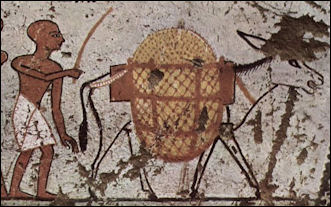
Donkeys were the first members if the horse family to be domesticated. They are believed to have been domesticated from wild asses, or onagers, from Arabia and North Africa about 6,000 years ago. See Assyria, Mesopotamia.
Onagers stand about 120 centimeters at the shoulder and weigh about 290 kilograms. They eat mostly sparse grasses and herbs that grow along desert edges. In the summer when water is scarce onagers survive by drinking salty water. Today onagers are threatened by loss of habitat, poaching and competition from grazing animals. About 800 onagers live in four remote desert areas of Iran.
Donkeys appeared in Egypt in the third millennium before Christ and are pictured on old Kingdom engravings dated to 2700 B.C., carrying people and loads in villages and urban areas. In the Old Testament the prophet Balaam was saved by a talking ass, who helped the prophet communicate with an angel he couldn’t see. In the New Testament Jesus made his final entry into Jerusalem on one. In Roman times, Nero's wife is said to have bathed in donkey milk scented with rose oil.
Sheep, Wool, and Ancient History
Famous reference to wool and sheep from the ancient world include Jason's quest for the Golden Fleece, Ulysses escaping from the Cyclops by clinging onto the underbelly of a ram, and Penelope's nightly unraveling of her weaving to keep suitors away until Ulysses returned. Salome's veils may have been wool and Cleopatra most likely used a wool carpet to smuggle herself in to see Caesar.╤
There are a number of references to wool-damaging pests in the ancient world. The Romans used bare-breasted virgins to beat away moths and beetles that ate their wool garments. Other cultures tried cow manure and garlic. Now we use moth balls. Proper washing is also supposed to be effective discouraging moths.
There are 300 references to sheep and lambs, more than any other animal, in the Old Testament, one the earliest documents that mentions sheep. Abraham, Moses and David tended a sheep at one time to make a living. Jacob gave Joseph a multicolored coat and Roman's drew lots to see who would get Jesus's cloak. Both garments were probably made of wool. During biblical times fleece was left out overnight in the desert to collect drinking water. In the morning dew was wrung out of it. ╤
Meat in Ancient Egypt

Bowl of fat
Ancient Egyptians ate the meat of cattle, sheep and goats. Lots of bones from slaughtered animals have been found. Hieroglyphics show ancient Egyptians hunting ducks, antelope and a variety of wild animals and using nets to catch birds as well as fish. There are even hieroglyphics describing slaves making foie gras.
The kind of meat that people at was an indicator of their wealth and status. Veal and roast goose were regarded as treats that generally only the upper classes could enjoy. The poor ate goat and muttons if they ate any meat all.
Pigs were eaten for a time but there was a prejudice against pork associated with Seth, god of evil. Pigs are depicted at a New Kingdom (1055-1069 B.C.) temple in El Kab, south of Luxor. As time went on the ancient Egyptians distanced themselves from pigs, regarding them as unclean, and abstained from pork. Herodotus wrote “the pig is regarded among them as an unclean animal so much so that if a man passing accidently touches a pig, he instantly hurries to the river and plunges in with his clothes on." Herodotus describes swineherds as an inbreed caste forbidden from setting foot in temples.
The Egyptians ate a lot of fish. They ate all the varieties that were found in the Nile and many from the Mediterranean. Archaeologists have found evidence e of fish processing operation, where fish were cleaned, salted and smoked. Fish was also made into sauce.
Meat mummies of an afterlife feast displayed at the Egyptian Museum include ducks, pigeons, legs of beef, roast and an oxtail for soup. They were all dried in natron, wrapped in linen and packed in a picnic basket. “Whether or not you got it regularly in life didn't matter because you got it for eternity," one archeologist said.
Meat and the Giza Pyramid Builders
Dr. Richard Redding and Brian V. Hunt wrote: “In an area of the world where people have traditionally reserved meat eating mostly for special occasions and feast-days, we have found evidence that the ancient state provisioned the pyramid city with enough cattle, sheep, and goat to feed thousands of people prime cuts of meat for more than a generation—even if they ate it every day. [Source: Dr. Richard Redding, Archaeozoologist, University of Michigan and Brian V. Hunt, Ancient Egypt Research Associates., ancientfoods.com, January 11, 2012 |]

food case, probably containing a preserved pigeon
“We have examined and identified over 175,000 bones and bone fragments from the excavations at the Giza pyramid settlement. The bones are from fish, reptiles, birds and mammals. About 10 percent have been identifiable to at least the level of the genus (a group of closely related species). Cattle and sheep dominate the fauna. We have found: 3,356 cattle fragments; 6,897 sheep and goat fragments; 536 pig fragments The ratio of individual sheep and goat to individual cattle is 5 to 1. |
“It might appear that sheep and goats were more common at Giza than cattle, and that sheep and goats were more important. But remember that an 18-month-old bull produces 10 to 12 times as much meat as an 18-month-old ram The ratio of sheep to goats at Giza is biased towards sheep. For the entire settlement site, the ratio of sheep to goat is 3 to 1. There is a low frequency of pig bones. |
“The cattle and sheep consumed at the settlement were young. 30 percent of the cattle died before 8 months, 50 percent before 16 months, and only 20 percent were older than 24 months. 90 percent of the sheep and goats survived 10 months, only 50 percent were older than 16 months, and only 10 percent older than 24 months. The cattle and sheep are predominately male. The ratio of male to female cattle is 6 to 1. The ratio of male to female sheep and goats is 11 to 1.” |
How Was So Much Meat Supplied for Giza Pyramid Builders
Dr. Richard Redding and Brian V. Hunt wrote: “What does this tell us about life at the pyramid settlement? The agrarian society of ancient Egypt was centered on crops and animals. The Egyptians’ colorful tomb paintings depict a rich agricultural life and we find evidence of this life in the archaeological remains of their settlements. The Egyptians could not catch fish, birds, and wild mammals in numbers adequate to support a large settlement like that at Giza. [Source: Dr. Richard Redding, Archaeozoologist, University of Michigan and Brian V. Hunt, Ancient Egypt Research Associates., ancientfoods.com, January 11, 2012 |]
“Feeding the pyramid builders required an increased production of domestic mammals: sheep, goats, cattle, and pigs. But there may have been inadequate space near Giza to support large herds of animals to feed the pyramid builders. Where did the supply of meat protein come from? Our models of animal use in the Middle East and Egypt are based on studies of the ecological, reproductive, productive, physiological and behavioral characteristics of domestic cattle, sheep, goats and pigs. These models help us make predictions. |
“The royal administrators had to develop a system that encouraged the production of animals beyond the needs of the villages of the Nile Delta and the Nile valley. They then collected the surplus and moved it along the Nile to Giza. If the Giza settlement was organized and provisioned by a central authority (the royal administration), then we expect certain evidence to emerge from the archaeological data. Based on our knowledge of agrarian societies and food production, the evidence at Giza should show: |
“Based on the data above, we see that the pyramid settlement at Giza was a well-provisioned site, supplied by the central authority; the archaeological pattern is not one of a livestock producing site. A central authority gathered predominately young, male sheep, goats, and cattle and brought them to the site to feed the occupants; the bones of these animals dominate the faunal remains and pigs are in very little evidence. |
“Without a central authority, this surplus creates a labor problem for herders and agriculturists. Do they reduce the herd size or increase meat consumption seasonally? It would therefore have been relatively easy for administrators to encourage villages to increase production. The central authority then becomes a convenient market for the surplus in exchange for goods and services. Imagine a division across the Nile Delta or Valley: cattle and goats in the middle and sheep and goats along the edges. Sheep and goats would go out into the high deserts in the rainy season and returned to the edges of the delta or valley in the dry season.” |
Animals Consumed by the Giza Pyramid Builders
Dr. Richard Redding and Brian V. Hunt wrote: “Pigs would have been unsatisfactory for provisioning a workforce on a large-scale in the ancient world. They cannot be herded and do not travel well over long distances. There are no nomadic pig herders anywhere in the world today. Pigs have a dispersed birthing pattern that is not seasonal; they give birth up to three times a year. Therefore, young pigs are available at almost anytime for consumption. Pigs provided no secondary products (hair, milk, etc.) and were therefore less valuable than cattle, sheep, and goats. Because of the pig’s unsuitability for feeding workers on a large scale, the Egyptian workforce administrators were not interested in them as stock, and pigs were not involved in inter-regional exchange the way other animal stocks like cattle, sheep, and goats were. [Source: Dr. Richard Redding, Archaeozoologist, University of Michigan and Brian V. Hunt, Ancient Egypt Research Associates., ancientfoods.com, January 11, 2012 |]
“Our studies indicate, however, that while the central authority did not consider pigs a valued provisioning resource, Egyptian families reared pigs for protein. Even today, in rural and urban areas around the world, farmers and non-farmers use pigs (where they are not proscribed by religion). |
“We know that the Egyptians recorded regular and detailed counts of animal stocks throughout the Nile Valley. These counts are a clear indication of the value of animals as a commodity to the state. Although they cannot provide the quantity of meat that cattle do, sheep and goats are valuable for similar reasons. They can be herded and provide secondary products. |
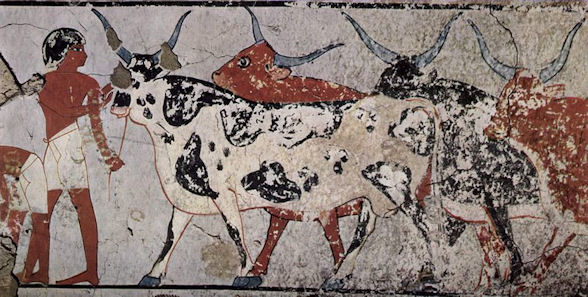
livestock
“Sheep, goats, and cattle can and do travel long distances. Americans in the 19th century drove cattle to market over vast distances. Nomadic sheep and goat pastoralists today move animals 1,000 miles (1,609 kilometers) by hoof in migration (e.g. Qashghi in Iran). In the 4th Dynasty, it was not possible to rear sheep, goats, and cattle around Giza in the numbers needed for the pyramid builders. We are working on an estimate of the farm area required to rear these animals in sufficient numbers to provide a surplus that would support 8,000-10,000 workers laboring at ancient Giza. Preliminary estimates suggest a required area substantially larger than the Giza environs would allow.
In Egypt, ranchers would have raised cattle in grassy areas with wells and watering holes like the Nile Delta. They would have raised sheep in the drier areas. Goats could have thrived in both places and would have complimented cattle rearing because these animals do not compete for food. The administrators would have organized drives of sheep, goats, and cattle between the Nile Valley and the high desert to move the required animals to Giza. In a foreshadowing of modern manufacturing, the animals would arrive in waves—a “just in time” delivery system. |
“Sheep, cattle, and goats all have secondary products beyond their meat: Sheep’s wool can be woven for cloth. Leather is valuable for clothing and tools. Cattle bones can be used to make tools. The ancient inhabitants may also have consumed milk from cows and goats, but not in such large quantities that it would have been signficant for the diet of the pyramid labor force. Secondary produce makes all of these animals more valuable resources. Sheep and goats have tight birthing seasons (compared to pigs) and produce age classes from which the young male surplus needs to be harvested. As with cattle, female sheep and goats are needed to produce offspring, while only a few males are needed for breeding.” |
Kom el-Hisn: the Meat Supply Center for the Giza Pyramid Builders?
Dr. Richard Redding and Brian V. Hunt wrote: “The Old Kingdom (5th and 6th Dynasty, 2465-2150 B.C.) Egyptian village, Kom el-Hisn, was excavated by archaeologists in 1985, 1986, and 1988. A contradiction appears in the archaeological record there. There is abundant evidence of cattle dung from the Old Kingdom level at Kom el-Hisn, which means there must have been large herds there. Yet the cattle bones indicate two things: the numbers of cattle slaughtered at Kom el-Hisn are relatively few and the bones that exist are from very old or very young individuals. [Source: Dr. Richard Redding, Archaeozoologist, University of Michigan and Brian V. Hunt, Ancient Egypt Research Associates., ancientfoods.com, January 11, 2012 |]
“Where are the prime, young males, which provide the best cuts of beef? The residents were not consuming the cattle they reared and were consuming few of the sheep. They only used very old animals or animals that were very young and ill. The residents of Kom el-Hisn were dependent on the pig as a source of protein and, unsurprisingly, we find a dominance of pig bone at the site. |
“Kom el-Hisn is just 4 kilometers from the ecotone where the Nile Valley meets the desert. The Egyptians could have reared cattle in the grassy areas around their villages and sent herders out with flocks of sheep and goats to exploit the ecotonal area. The royal cattlemen periodically gathered up herds of young, male cattle and sheep (1 to 2 years) and drove them along the Nile to a central point for redistribution. These young male animals were not consumed locally and so their remains did not enter the archaeological record at Kom el-Hisn. |
“Cattle were raised at Kom el-Hisn but not consumed there. Where were the consumers? We hypothesize that Kom el-Hisn was a regional or provincial center for raising cattle, but that the young males were sent to the core area of the Old Kingdom state—the capital zone and the pyramid zone—for feeding cities. Our systematic excavations and retrieval of animal bone from such core-area settlements, like Giza, allow us to test our hypothesis. In fact, we find the inverse ratios of Kom el-Hisn: lots of cattle, sheep, and goat but very little pig.” |
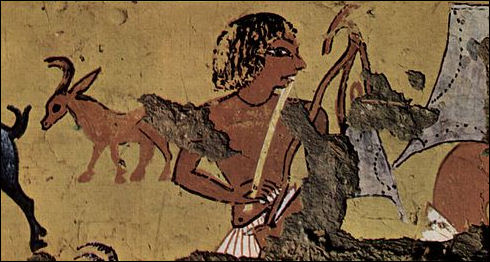
shepherd
Leatherworking in Ancient Egypt
André J. Veldmeijer of the Netherlands Flemish Institute in Cairo wrote: “Leather was used throughout Egypt’s history, although its importance varied. It had many applications, ranging from the functional (footwear and wrist-protectors, for example) to the decorative (such as chariot leather). Although leather items were manufactured using simple technology, leatherworking reached a high level of craftsmanship in the New Kingdom. Among the most important leather-decoration techniques employed in Pharaonic Egypt, and one especially favored for chariot leather, was the use of strips of leather of various colors sewn together in partial overlap. In post-Pharaonic times there was a distinct increase in the variety of leather-decoration techniques. Vegetable tanning was most likely introduced by the Romans; the Egyptians employed other methods of making skin durable, such as oil curing.” [Source: André J. Veldmeijer, Netherlands Flemish Institute Cairo, UCLA Encyclopedia of Egyptology 2008, escholarship.org ]
“The term “leather” refers to skins that have been tanned or tawed—that is, converted into white leather by mineral tanning, as with alum and salt—rather than cured. In Egypt it appears that skins were not tanned or tawed in the Pharaonic Period; however, thus far we lack detailed, systematic chemical analyses from which to make a conclusive determination. Skins and leather were used throughout Egyptian history, but their importance and quality varied. According to Van Driel- Murray, skins were widely used in the Badarian and Amratian (Naqada I) periods but were largely superseded by cloth in the Gerzean (Naqada II).
“In the Old and Middle kingdoms the use of leather declined in favor of the use of fiber and textiles; skins seem to have been of secondary importance to meat and the production of glue. The Nubian “pan-grave” cultures, however, introduced decorated leather garments, including the loincloth, and containers and pouches of high quality, not dissimilar to those of Predynastic traditions and comparable to leatherwork recovered from other Nubian sites, such as Kerma. During the New Kingdom leather was much more widely used. New weapons technology—such as the introduction of the chariot by Asiatic peoples—was partially responsible for this. Contact with foreign cultures might also have been the reason for the introduction of the leather shoe. It is difficult to say whether the use of leather continued to the same extent into the Third Intermediate Period. The situation in the Late and Ptolemaic periods is as enigmatic. Better attested is leather from the Roman Period, during which the use of vegetable-tanned leather became widespread and in which innovations in technology are apparent.
“In Egypt leather was most commonly made from the skins of cow, sheep, goat, and gazelle, although those of more exotic species such as lion, panther, cheetah, antelope, leopard, camel, hippopotamus, crocodile, and possibly elephant have been identified. Leather was used in a wide variety of items, ranging from clothing, footwear, and cordage, to furniture and (parts of) musical instruments.
Processing of Skins Into Leather in Ancient Egypt
André J. Veldmeijer of the Netherlands Flemish Institute in Cairo wrote: “The processing of skins into leather is virtually universal and is well documented. Scenes from the tomb of Rekhmira provide especially useful information. According to Forbes’s analysis of leather processing, after a skin was flayed, underlying fat and hair were removed by rubbing urine, ash, or a mixture of flour and salt into the haired surface. Next, the skin was cured, arresting the degenerative process.[Source: André J. Veldmeijer, Netherlands Flemish Institute Cairo, UCLA Encyclopedia of Egyptology 2008, escholarship.org ]
“Curing in oil seems to have been the preferred method in Pharaonic Egypt, although mineral curing was probably practised, particularly in the Predynastic Period. After having been soaked in oil, the skin was staked to make it supple and the remaining oil was worked into the skin. Finally, the skin would be dried. Although vegetable tanning is the only means of producing chemically stable leather, current scholarly opinion maintains that tanning was unknown in Egypt before the Greco-Roman Period. An explanation for this may be that the Romans, who had experienced a comparatively wetter environment that required them to adopt the use of vegetable-tanned leather, brought the technique to Egypt, where the arid climate had not rendered tanning a necessity. However, Nubian leatherwork, including leatherwork of the Nubian C-Group at Hierakonpolis, differs from Egyptian leatherwork in many respects, one of which seems to be its processing methods, which possibly included vegetable tanning. Indeed the results of a field test for vegetable tanning were convincingly positive. Problems with the test have been noted, however; its further analysis, currently in progress, is needed. Furthermore, the question as to why vegetable tanning may have been employed in Nubia remains to be answered.”

cattle rescued from floodings
Leather Manufacturing and Tools in Ancient Egypt
André J. Veldmeijer of the Netherlands Flemish Institute in Cairo wrote: “Leather-manufacturing techniques were basic: leather goods were sewn with simple, but varied, seams, using flax, sinew, or narrow leather thongs. Rawhide (unprocessed skin) was generally used for lashing, as it shrinks upon wetting and thus tightens the components of the object being fastened. Rawhide was therefore employed to fasten ax blades onto their shafts and to form the “joints” of furniture. Because of its hardness and durability, it was sometimes used to provide the soles of footwear. Despite the simplicity of manufacturing techniques, some Egyptian leatherwork reached a high level of craftsmanship. [Source: André J. Veldmeijer, Netherlands Flemish Institute Cairo, UCLA Encyclopedia of Egyptology 2008, escholarship.org ]
“Before the New Kingdom, mineral dyes were used to color leather. The complete palette of colors used is hard to establish, as some shades are more susceptible to discoloration than others—such as blue, apparently, given its few surviving examples. Abundantly used were bright red and green, often in combination. Shoes very similar to the one depicted have been found in Deir el Medina and date to the New Kingdom.
“White may have been obtained by manipulation of the skin surface, already pale due to processing, with pastes of chalk mixed with fats. Vegetable dyes, such as madder (red), indigo (blue), and pomegranate (yellow and black), with alum as a mordant, appeared after the 18th Dynasty. Gilding came into use as late as the Coptic Period. Several other techniques of leather-decoration were also used: decoration with beads is known from as early as the Predynastic Period; cutting (incision) was featured from the Old Kingdom onward; and stamping and multicolor appliqué are known starting from the New Kingdom.
“Leatherworking tools included large pots for dipping, the trestled beams used for staking, and the low stools and platforms upon which much of the processing was carried out. Needles of bone and probably copper were used for stitching leather from the earliest times. Leather may have been pricked prior to stitching in order to facilitate penetration with a needle; awls of bone (later of metal) and marlin spikes would have been used for this purpose.
“Most leather cutting was performed using curved knives with either broad or narrow blades. Pounders for smoothing, depilation, and working in oils and fats would also have been widely used. Slickers—that is, blades with triangular anti-clogging holes—may have been used for any of the above-mentioned purposes and would have been preceded by the flint scraper. Tools for incised decoration would have been necessary: there are many examples of pointed tools that could have served this purpose. Stamps would probably have been cast from metal or carved from stone, or possibly wood, although no such examples have been identified as yet. It is archaeologically difficult to confirm the presence of tanning pits. A possible leather workshop from the Greco-Roman Period was excavated at Akoris.”
Hunting in Ancient Egypt
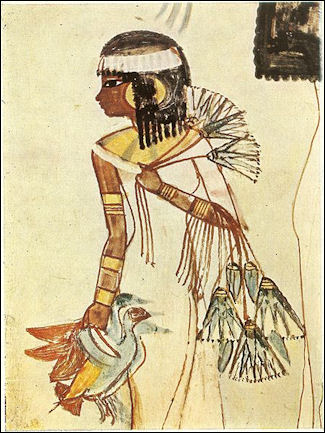
female hunter
The Egyptians speared hippos and hunted animals such as ibex and antelope in a region they called “ deshret” . Hunting and battle scenes were commonly drawn. Some depict dogs biting antelopes, ostriches squawking in terror and horses, hyenas and hartebeests on the run. In background hieroglyphic images sometimes explain what is going on. The ancient Egyptians used boomerangs. Forth millennium B.C. drawings show hounds hunting with men and driving game into nets. Ducks were hunted with throw sticks by men hiding in the reeds
According to a 1955 Sports Illustrated article “Egyptian artists, through the many centuries of great empire under the Pharaohs in the Nile Valley, created indisputable masterpieces, not a few of which depicted sports. Many of them suffered the depredations of time and man and no longer remain to be admired. In time they cover several eras. The little painting, Birds in an Acacia Tree, dates from about 1900 B.C. The painting of the youthful King Tut'ankhamun was done about 3,300 years ago. The fine hunting and fishing scenes are of an earlier period. Yet in each, one finds the same magnificent colors, the flawless sense of composition and the decorative richness of stylization. These are paintings of genre type, biographical in nature. They tell of pleasures enjoyed in earthly life, to be continued in life beyond the grave. The animals, birds and fish are among the classic wildlife paintings of all time. [Source: Sports Illustrated, September 26, 1955]
“1) "Tut' Ankhamun Hunting Lions" a decoration from the lid of a box found in the young Pharaoh's tomb, is a scene of magnificence and violence. Papyrus thickets on the banks of the Nile were fine hunting and fishing grounds for elite of Thebes, who made a day of sport into a family outing 2) "Fishing and Fowling in the Marshes" shows the use of throwing stick and spear. At left the hunter holds live birds as decoys while a trained cat flushes the birds. 3) "Hunting Wild Fowl in the Marshes" again illustrates the throwing stick, the live decoys and the trained cat. The sportsman, accompanied by his wife and daughter, has nonchalantly draped lotus flowers over his shoulder, while his little girl keeps him from falling off the reed boat by hanging onto his leg.”
Fishing in Ancient Egypt
Fish were caught in the Nile and the Mediterranean. Reliefs show fishermen using nets and harpoons to catch fish in shallow water. At the Temple of Hatshepsut there is a scene of birds being captured in nets.
According to Minnesota State University, Mankato: “Agricultural crops were not the mainstay of the ancient Egyptian diet. Rather, the Nile supplied a constant influx of fish which were cultivated year around.”[Source: Minnesota State University, Mankato, ethanholman.com]
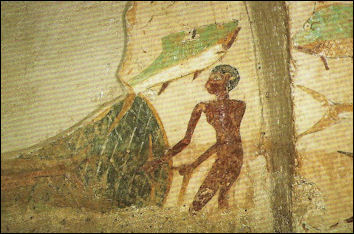
fishing The Egyptians ate a lot of fish. They ate all the varieties that were found in the Nile and many from the Mediterranean. Archaeologists have found evidence of fish processing operation, where fish were cleaned, salted and smoked. Fish was also made into sauce. Reliefs show fishermen using nets and harpoons to catch fish in shallow water. At the Temple of Hatshepsut there is a scene of birds being captured in nets.
André J. Veldmeijer of the Netherlands Flemish Institute in Cairo wrote: “Pictorial evidence shows that fishing boats were generally small, able to be operated by one to five persons. Vessels might be rafts made of papyrus bundles (e.g., as seen in the papyrus models Y from the Middle Kingdom tomb of Mekhet-Ra) or made of wood (excellent illustration in the Ramesside tomb of Ipy). Many illustrations of fishing from boats show fishermen using various types of nets, sometimes (as in the two Mekhet-Ra papyrus boat models) with two craft working together. Other methods used from boats or rafts were spearing and line-fishing (see in general van Elsbergen 1997). Depictions of fishing are especially common in the Old Kingdom, but can be found in the Middle and New Kingdoms as well; documentary evidence for commercial fishing continues on into the Ptolemaic and Roman Periods, when there is at least some evidence for women involved in the occupation.[Source: André J. Veldmeijer, UCLA Encyclopedia of Egyptology 2009, escholarship.org ]
Netting in Ancient Egypt
André J. Veldmeijer of the Netherlands Flemish Institute in Cairo wrote: “The spinning of flax thread for the production of textiles is well known and described in detail by various authors. Vogelsang-Eastwood suggests that first the flax fibers were loosely twisted and then spun into the final thread in a second stage. Usually, flax fibers were wetted before being spun, after which the thread could be plied, used in the manufacture of textiles, or, less commonly, made into a net, most of the flax netting having been made of plied string.” [Source: André J. Veldmeijer, UCLA Encyclopedia of Egyptology 2009, escholarship.org ]
“Egyptian netting was most commonly used in fishing and for carrying/holding objects, such as jars and beakers. Fishing and carrier nettings were usually made with different knots. Fishing nets were exclusively made with mesh knots, whereas carrier nets were made with overhand knots, in addition to mesh knots. The carrier net was one of several included in the intact burial of a woman and child found by Petrie in 1908 at Dra Abu el Naga; these were constructed with half knots and bore strong parallels to the Kerma netting described by Reisner . Knotless netting, a technique used for various objects ranging from carrier nets to sieves, is reported. “Sprang” netting (a particularly flexible form of netting) does not occur in Egypt before the Roman Period.
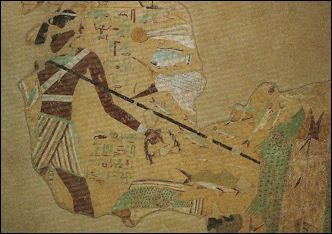
fishing “Wendrich has described in detail the production of netting made with mesh knots. First, a row of loops was knotted to a border string. A subsequent row of loops was then knotted to the first, and so on, using a netting needle. It should be noted that Wendrich’s description focuses on mesh- knot netting constructed of knots having the same orientation per row, each row alternating in direction. Veldmeijer suggests alternative production processes for netting with non- alternating rows or with variously oriented knots. The knotting of reef-knot netting differed slightly: although the net was constructed from either left to right or right to left, the knots were oriented horizontally rather then vertically as they were in mesh- knot netting. Alternatively, reef-knot nets may also have been manufactured by pulling hitches, which involved a netting needle. Finally, handles, weights, and floaters were tied to the net when appropriate.
“The production of fishing nets was depicted in Egypt as early as the Old Kingdom. Well- known examples include the depictions of net makers in the Middle Kingdom tombs of Beni Hassan. The essential task of fishing-net repair was also depicted in some Old Kingdom tombs. An example from the New Kingdom can be found in the tomb of Paheri.”
Image Sources: Wikimedia Commons
Text Sources: UCLA Encyclopedia of Egyptology, escholarship.org ; Internet Ancient History Sourcebook: Egypt sourcebooks.fordham.edu ; Tour Egypt, Minnesota State University, Mankato, ethanholman.com; Mark Millmore, discoveringegypt.com discoveringegypt.com; Metropolitan Museum of Art, National Geographic, Smithsonian magazine, New York Times, Washington Post, Los Angeles Times, Discover magazine, Times of London, Natural History magazine, Archaeology magazine, The New Yorker, BBC, Encyclopædia Britannica, Time, Newsweek, Wikipedia, Reuters, Associated Press, The Guardian, AFP, Lonely Planet Guides, “World Religions” edited by Geoffrey Parrinder (Facts on File Publications, New York); “History of Warfare” by John Keegan (Vintage Books); “History of Art” by H.W. Janson Prentice Hall, Englewood Cliffs, N.J.), Compton’s Encyclopedia and various books and other publications.
Last updated September 2018

